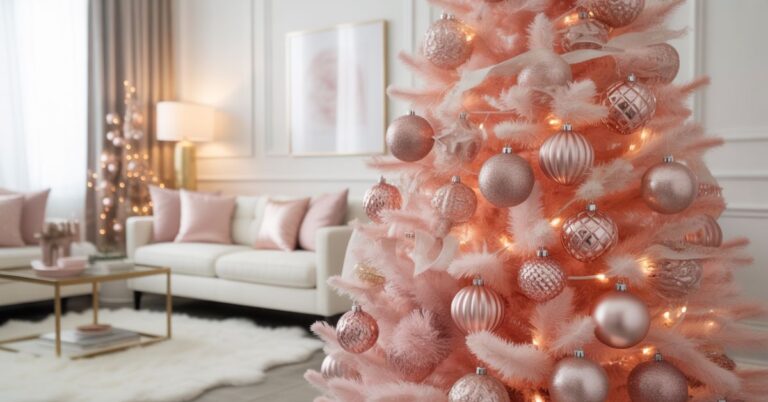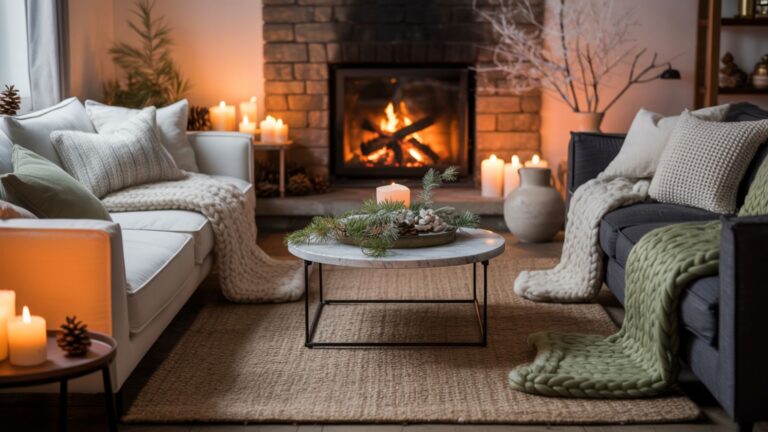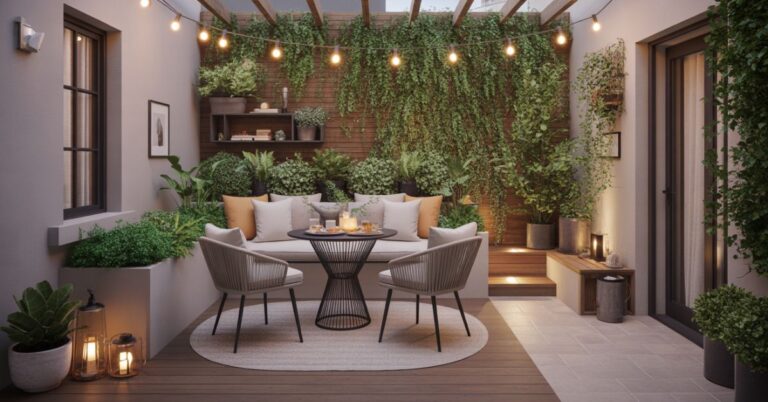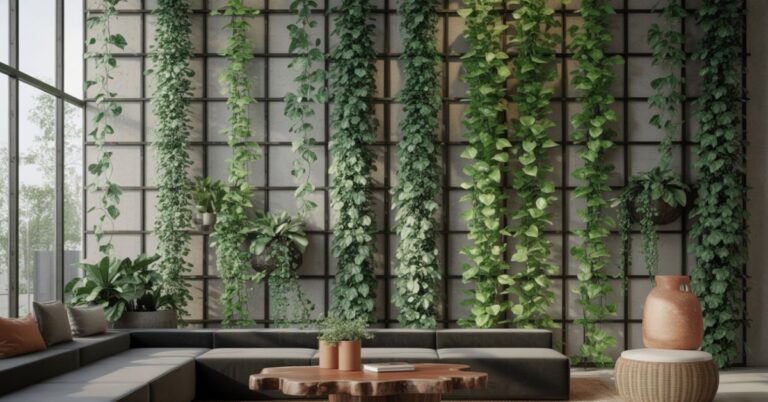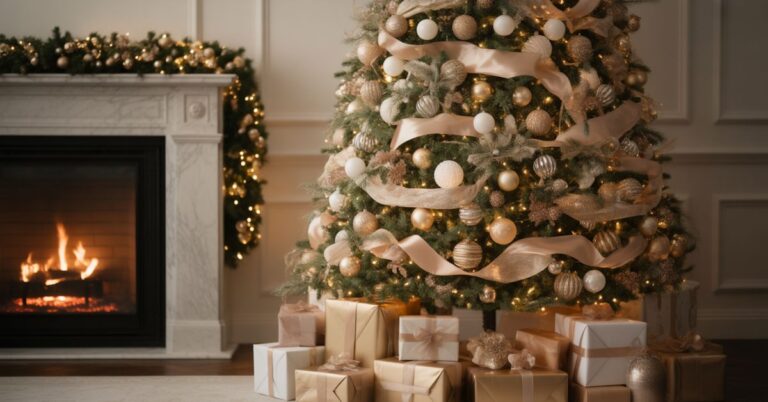50+ Gorgeous Outdoor Artificial Flower Pot Ideas for Year-Round Beauty
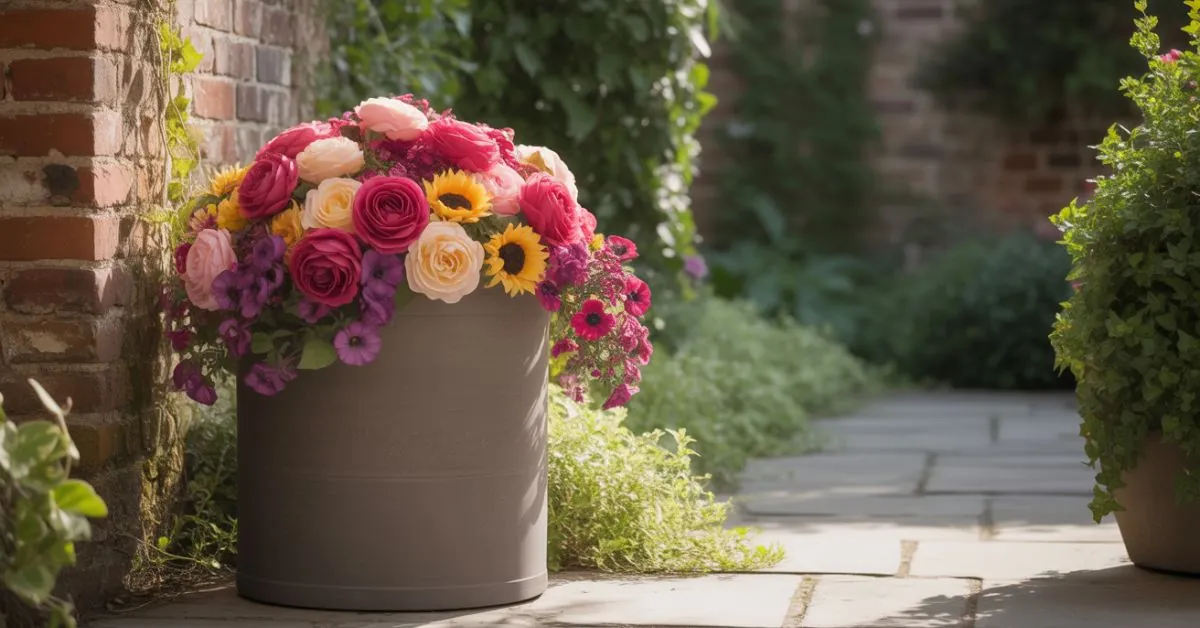
Your neighbors constantly compliment your gorgeous flower displays that look perfect in every season, never showing signs of wilting or weather damage. Meanwhile, their real plants struggle through summer heat waves and winter freezes, requiring constant replanting and maintenance just to achieve half the impact of your effortlessly beautiful arrangements.
The frustration of watching expensive live flowers die from unexpected weather, pest damage, or vacation neglect has driven countless homeowners to discover the game-changing world of outdoor artificial flower pot ideas. These weather-resistant displays solve every gardener’s nightmare: no more dead plants, constant watering schedules, or seasonal replanting marathons that drain both time and budgets.
Outdoor artificial flower pot ideas provide the perfect solution for creating stunning year-round displays that maintain their beauty through scorching summers, freezing winters, and everything in between, while delivering the curb appeal you’ve always wanted without the ongoing maintenance headaches.
Why Choose Artificial Flowers for Outdoor Containers
Weather resistance is one of the strongest benefits of an Outdoor Artificial Flower Pot compared to live plants. A high-quality Outdoor Artificial Flower Pot made with UV-resistant materials retains its vibrant colors and resists fading, even under harsh sunlight or extreme weather conditions that quickly damage natural blooms. With an Outdoor Artificial Flower Pot, your displays remain fresh-looking year-round without worrying about seasonal wear.
Maintenance-free gardening is another key advantage of an Outdoor Artificial Flower Pot. Unlike traditional planters, an Outdoor Artificial Flower Pot requires no watering, fertilizing, or pest control, saving hours of daily upkeep. Homeowners, frequent travelers, and those with physical limitations all benefit from the ease of an Outdoor Artificial Flower Pot, as it offers beauty without effort.
Cost-effectiveness becomes clear after just one season of using an Outdoor Artificial Flower Pot. While the initial purchase of a premium Outdoor Artificial Flower Pot may seem higher, it eliminates ongoing costs like replacement plants, soil, fertilizer, and pest treatments. In the long run, an Outdoor Artificial Flower Pot provides lasting savings while maintaining a flawless display.
Design flexibility sets the Outdoor Artificial Flower Pot apart from live arrangements. With an Outdoor Artificial Flower Pot, you can mix tulips, roses, and mums in a single display, achieve perfect symmetry, and experiment with vibrant color palettes not found in nature. An Outdoor Artificial Flower Pot allows endless creativity, making it a versatile choice for stylish outdoor décor.
Essential Materials for Outdoor Artificial Displays
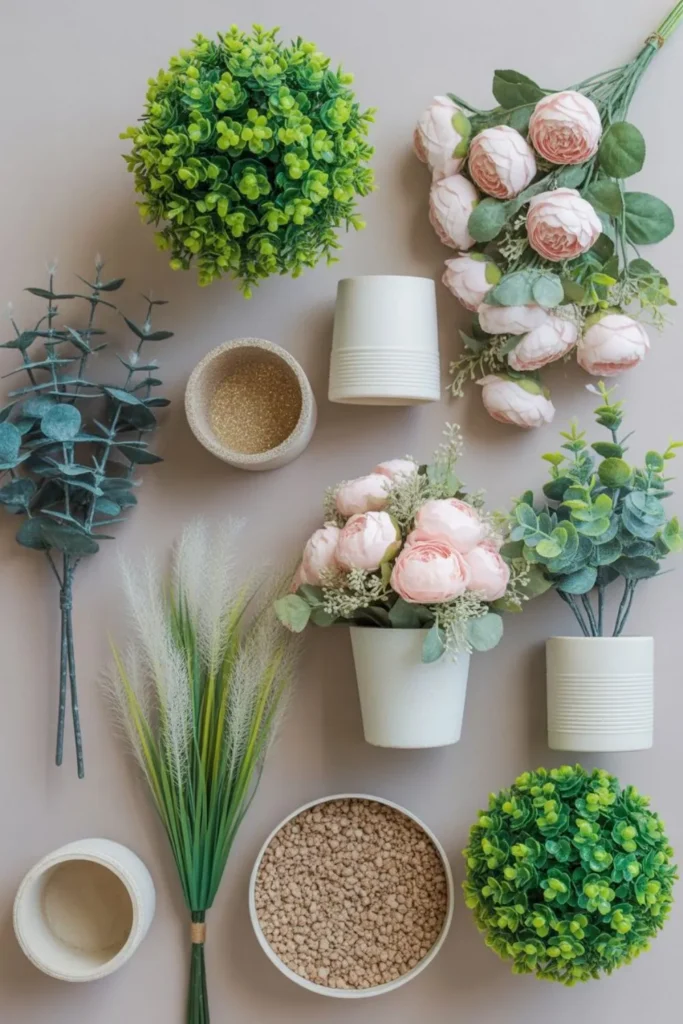
Selecting Weather-Resistant Artificial Flowers
A high-quality Outdoor Artificial Flower Pot resists moisture absorption and prevents color degradation, ensuring long-lasting vibrancy. Premium Outdoor Artificial Flower Pots often feature wire-reinforced stems, realistic texture variations, and manufacturer warranties guaranteeing minimal fading for 2–3 years.
Fade-resistant coatings further enhance the durability of an Outdoor Artificial Flower Pot, protecting artificial petals and leaves from sun damage that would make cheaper flowers look obviously fake within months. Each Outdoor Artificial Flower Pot is carefully manufactured and treated to withstand light exposure, while additional considerations may be required for extreme temperature protection to maintain its pristine appearance.
Choosing Appropriate Outdoor Containers
Drainage requirements remain important even for artificial flower containers to prevent water accumulation that breeds mosquitoes or damages foam bases. Drill additional holes in solid-bottom planters or choose containers with built-in drainage systems.
Container materials should complement the durability of artificial flowers while withstanding outdoor conditions. Weatherproof planters in fiberglass, composite materials, or powder-coated metals provide longevity that matches artificial flower lifespans.
Size considerations affect both visual impact and arrangement stability. Larger containers provide better proportion with substantial artificial arrangements while offering weight and wind resistance that prevents tipping during storms.
Read More About: 60+ Large Flower Pot Ideas to Transform Outdoor Spaces
Popular Artificial Flower Types for Outdoor Use
All-Season Performers
Artificial roses are a top choice for Outdoor Artificial Flower Pot ideas due to their timeless appeal and excellent weather resistance. Modern Outdoor Artificial Flower Pots featuring artificial roses showcase layered petals with natural color variations, realistic thorns, and sturdy stems that maintain their shape even in extreme outdoor conditions.
Artificial hydrangeas create impressive volume and visual impact in any Outdoor Artificial Flower Pot, with large, clustered blooms that serve as striking focal points. Their full, rounded shapes add presence to weatherproof planters, and the subtle color shifts from soft blue to deep purple enhance the realism of each Outdoor Artificial Flower Pot arrangement.
Artificial geraniums provide reliable color and classic charm, making them ideal for Outdoor Artificial Flower Pot displays across various architectural styles. These 18″ artificial geranium bushes, crafted from durable polyester, retain vibrant colors without maintenance, ensuring every Outdoor Artificial Flower Pot remains beautiful year-round.
Seasonal Specialty Options
Spring artificial flowers like tulips, daffodils, and cherry blossoms extend early season beauty well beyond natural flowering periods. These varieties allow you to enjoy spring colors starting weeks before real gardens emerge from winter dormancy.
Summer heat-tolerant varieties including sunflowers, marigolds, and zinnias provide bold, vibrant colors that actually benefit from intense sunlight rather than wilting under extreme temperatures like their living counterparts.
Fall-themed arrangements featuring chrysanthemums, asters, and decorative branches provide autumn beauty that lasts throughout the season without succumbing to early frosts that typically end natural fall displays prematurely.
Design Principles for Outdoor Artificial Arrangements
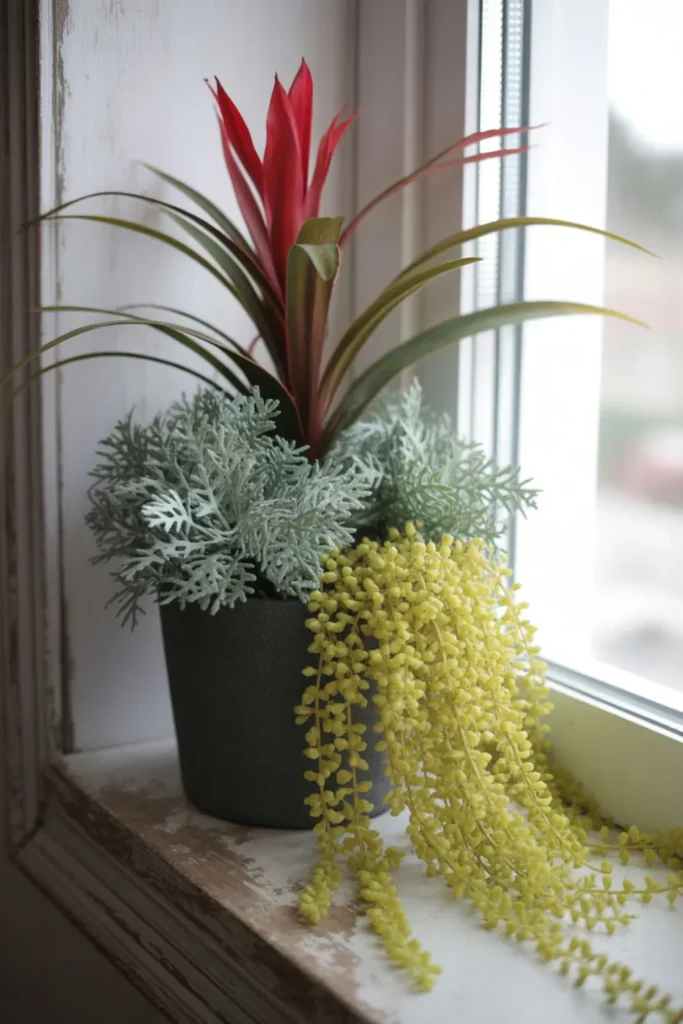
Color Theory and Seasonal Planning
Monochromatic schemes create sophisticated elegance using varying shades of single colors that work particularly well for outdoor artificial flower pot ideas. Deep burgundy, golden yellow, or soft purple palettes provide cohesive beauty while preventing the “obviously artificial” appearance that mixed random colors often create.
Complementary color combinations generate vibrant contrast that draws attention from considerable distances. Purple and yellow, orange and blue, or red and green pairings create dynamic displays that enliven outdoor spaces while maintaining professional appearance standards.
Peach Fuzz is the choice for 2024 and represents “a warm, cozy shade highlighting our desire for togetherness”, making it an excellent foundation color for creating welcoming artificial flower containers that reflect current design trends.
Scale and Proportion Guidelines
Thriller, filler, spiller principles apply equally to artificial arrangements as living displays. Place tall, dramatic specimens in container centers or backs, surround them with medium-height volume flowers, and finish with trailing elements that cascade over edges naturally.
Height relationships should follow natural proportions with tallest elements measuring 1.5-2 times container height for balanced appearance. Artificial outdoor flowers maintain consistent proportions throughout seasons, unlike living plants that change dramatically as they grow.
Textural variety prevents flat, lifeless arrangements that immediately identify displays as artificial. Combine smooth-petaled roses with textured varieties, pair broad leaves with narrow grass-like foliage, and include elements with different surface finishes for authentic diversity.
Creative Container Ideas for Artificial Displays
Traditional and Classic Options
Terra cotta and ceramic planters provide timeless appeal while offering excellent compatibility with artificial outdoor flowers. These materials offer natural porosity that prevents moisture buildup while providing substantial weight for arrangement stability.
Wooden containers in cedar or composite materials create rustic charm that complements artificial displays beautifully. Line wooden planters with landscape fabric to prevent moisture damage while maintaining drainage capabilities.
Stone and concrete vessels deliver maximum durability and weather resistance while providing substantial visual weight that anchors outdoor artificial flower pot ideas effectively in high-wind locations.
Creative and Repurposed Solutions
Unique vessel conversions transform everyday items into distinctive artificial flower containers that showcase personal creativity. Vintage wheelbarrows, galvanized buckets, or decorative crates provide character that mass-produced planters cannot match.
Architectural salvage planters incorporate building materials like chimney pots, sink basins, or industrial containers into garden designs. These one-of-a-kind options provide conversation starters while offering generous capacity for elaborate arrangements.
Multi-level display systems create dynamic presentations using containers at varying heights. Tiered plant stands, wall-mounted brackets, or hanging systems maximize vertical space while showcasing different artificial flower varieties at optimal viewing levels.
How Do You Secure Artificial Flowers in Outdoor Pots?
Foam base systems provide the most reliable foundation for outdoor artificial flower displays. Use floral foam specifically designed for artificial arrangements rather than fresh flower foam, which deteriorates when exposed to moisture over time.
Weighted anchoring techniques ensure arrangements remain stable during wind storms and severe weather. Add decorative stones, sand, or specialized floral weights to container bottoms before installing foam bases, creating a low center of gravity that prevents tipping.
Wire reinforcement methods secure individual stems while allowing natural-looking positioning. Twist flower stems together before insertion, or use floral wire to create anchor points that maintain arrangement integrity through weather challenges.
Protective treatments extend both flower and securing material life. Apply fabric protector sprays to artificial petals and leaves, while coating foam bases with waterproof sealers prevents moisture absorption that leads to deterioration.
What Size Containers Work Best for Artificial Flowers?
Proportional guidelines ensure artificial outdoor flowers appear balanced and natural rather than obviously fake. Large containers (20+ inches diameter) accommodate dramatic, full arrangements with multiple flower types, while medium containers (12-20 inches) work well for mixed displays with 3-5 varieties.
Volume requirements matter more than diameter measurements for securing artificial arrangements effectively. Containers should provide adequate depth (minimum 8-10 inches) for proper foam installation and stem insertion while maintaining stability.
Weight distribution considerations become important since artificial displays lack soil weight for natural ballast. Heavy containers provide necessary stability for large arrangements, while lightweight options work for smaller displays positioned in protected locations.
Multiple container groupings allow size variation that creates dynamic landscape compositions. Combine large statement containers with smaller accent pieces, varying heights and flower types for professional-looking displays.
Seasonal Styling with Artificial Flowers
Spring Refresh Strategies
Early season transitions should begin 4-6 weeks before natural spring blooms appear locally. This timing provides an early color impact that makes homes stand out while neighbors’ gardens remain winter dormant.
Layered spring elements allow gradual seasonal transitions rather than complete arrangement replacements. Add artificial outdoor flowers like tulips and daffodils to existing evergreen bases, incorporating pussy willow branches or flowering tree elements for authentic appeal.
Color palette shifts from winter’s deep greens and burgundies toward lighter pastels and fresh yellows signal seasonal change effectively. Soft pink, lavender, and cream combinations create gentle transitions that feel natural and welcoming.
Summer Bold and Vibrant Displays
Heat-resistant arrangements should embrace colors and scales that compete effectively with intense sunlight. UV resistant flowers in bold oranges, bright reds, and sunny yellows maintain visibility and impact even during harsh summer conditions.
Tropical themes work particularly well with artificial flower containers since you can combine plants from different climate zones without compatibility concerns. Mix artificial birds of paradise with hibiscus and palm fronds for exotic appeal.
Patriotic combinations for summer holidays offer opportunities for red, white, and blue themes that celebrate seasonal traditions. Artificial outdoor flowers hold their colors perfectly through July heat that would wilt natural patriotic displays quickly.
Autumn Warmth and Winter Structure
Fall color transitions should embrace rich, warm tones that complement seasonal decorations and architectural elements. Deep burgundy, golden yellow, burnt orange, and russet brown create arrangements that enhance autumn landscape beauty.
Winter structural elements focus on form and texture rather than bright colors during dormant seasons. Incorporate evergreen branches, berry clusters, and seed pods that provide interest when flower colors seem inappropriate for season.
Holiday adaptations allow weatherproof planters to serve multiple purposes throughout winter months. Design base arrangements that accommodate Christmas decorations, New Year’s metallics, or Valentine’s Day additions without requiring complete reconstruction.
Read More About: 55 The Cutest Flower Pot To Unleash Your Creativity
Maintenance and Care for Outdoor Artificial Flowers
Cleaning and Preservation
Regular maintenance schedules keep artificial outdoor flowers looking fresh and realistic. Monthly gentle cleaning with mild soap and lukewarm water removes dust, pollen, and environmental buildup that dulls colors and creates obviously artificial appearances.
Deep cleaning techniques involve complete disassembly for thorough maintenance. Remove all flowers from containers, clean foam bases and securing materials, and inspect individual stems for damage or excessive wear that requires replacement.
Protective treatment applications help maintain color and material integrity throughout seasons. UV-protectant sprays designed for outdoor fabrics extend artificial flower life, while anti-static treatments reduce dust accumulation between cleanings.
Storage and Weather Protection
Extreme weather precautions protect investments during hurricanes, hail storms, or extended harsh conditions. While quality UV resistant flowers handle normal weather, severe conditions may require temporary removal and protected storage.
Seasonal storage considerations apply to arrangements designed for specific holidays or seasons. Store Christmas, Halloween, or spring-specific displays in climate-controlled areas with proper ventilation to prevent mold or material degradation.
Rotation strategies extend arrangement life by alternating displays seasonally rather than leaving identical arrangements exposed year-round. This approach reduces sun exposure while maintaining fresh appearances throughout seasons.
Budget-Friendly Artificial Flower Solutions
Cost-Effective Shopping Strategies
Wholesale purchasing options provide significant savings for large projects or multiple arrangements. Many wholesale suppliers sell to consumers, offering commercial-grade artificial outdoor flowers at substantially lower per-unit costs.
End-of-season clearances offer opportunities to purchase premium artificial flower containers and flowers at 40-70% discounts. Plan ahead by buying Christmas arrangements in January or spring flowers in late spring for next year’s displays.
Quality versus price analysis helps identify best values in UV resistant flowers. Sometimes mixing a few high-quality focal flowers with budget filler elements creates attractive results while controlling costs effectively.
DIY Enhancement Techniques
Realistic weathering improves obviously new artificial flowers through light applications of diluted paint or tea staining that adds natural-looking age and character. This technique works particularly well for rustic or cottage-style arrangements.
Custom color modifications allow perfect coordination with home exteriors through fabric dyes or spray paints designed for plastics. Test techniques on hidden areas before applying to visible surfaces for best results.
Arrangement combinations mixing artificial and preserved natural elements create unique displays. Combine artificial flowers with real dried branches, preserved moss, or natural stones for authentic textures.
Common Mistakes to Avoid
Selection and Planning Errors
Quality compromises represent false economy in outdoor artificial flower pot ideas. Cheap flowers fade quickly, look obviously fake, and require frequent replacement, ultimately costing more than quality initial investments.
Scale misjudgments create arrangements that look awkward or out of proportion. Tiny flowers in massive containers or oversized arrangements in small spaces immediately signal poor planning and amateur execution.
Seasonal inappropriateness occurs when flower selections don’t match regional growing seasons. Christmas poinsettias in July or spring tulips in October look obviously artificial and detract from overall landscape credibility.
Installation and Maintenance Issues
Inadequate securing results in arrangements that shift, fall apart, or blow away during normal weather conditions. Take time to properly anchor all elements and test stability before considering installations complete.
Neglecting drainage creates problems even with artificial arrangements through standing water that breeds mosquitoes, promotes mold growth, or damages securing materials over time.
Maintenance procrastination allows dust, debris, and environmental buildup to create obviously artificial appearances that defeat the purpose of realistic flower investments.
Advanced Design Techniques
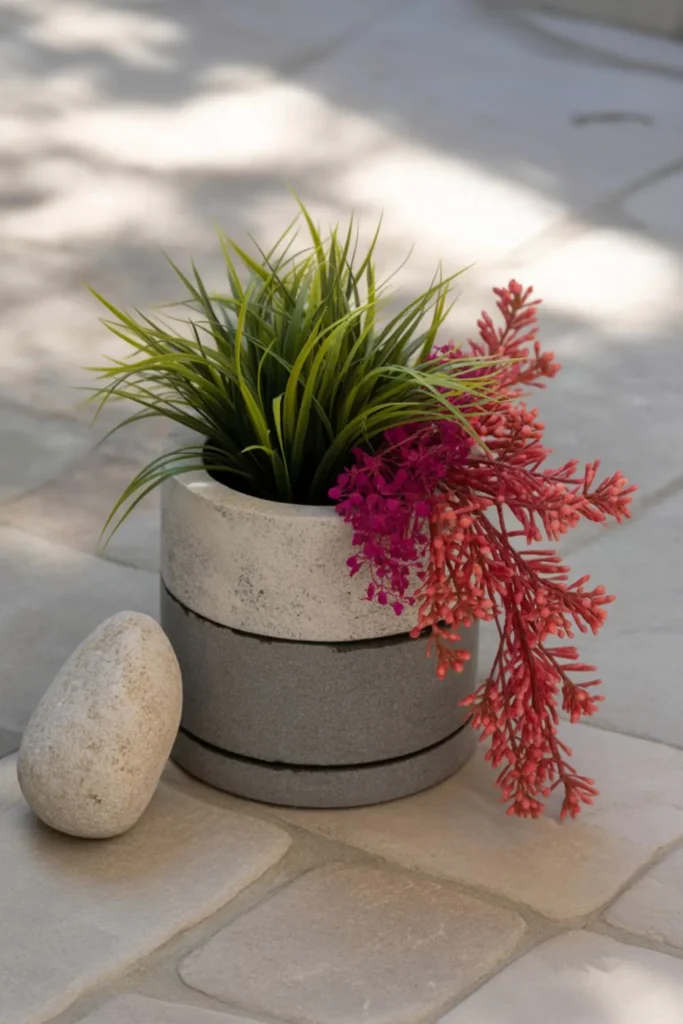
Professional-Level Arrangements
Naturalistic randomness requires deliberate effort to avoid the perfect uniformity that immediately identifies artificial displays. Vary stem heights slightly, angle flowers differently, and create small gaps that mimic natural growth patterns.
Depth layering creates three-dimensional interest through strategic placement of flowers at different distances from container edges. This technique adds realism while preventing the flat appearance that characterizes amateur artificial arrangements.
Color flow principles guide viewers’ eyes through arrangements using strategic placement of lighter focal colors, darker depth elements, and medium transition tones that create visual harmony.
Seasonal Adaptation Methods
Modular design systems allow easy seasonal updates without complete arrangement reconstruction. Design core structures that accommodate seasonal additions, removals, and modifications throughout the year.
Quick-change techniques enable rapid holiday or special occasion transformations. Plan base arrangements that accept decorative additions like ribbons, ornaments, or seasonal accents without disturbing fundamental structures.
Progressive enhancement builds arrangements gradually over time rather than creating complete displays immediately. This approach spreads costs while allowing refinements based on actual performance and personal preferences.
Conclusion
Outdoor artificial flower pot ideas represent the ultimate solution for homeowners seeking year-round beauty without the constant maintenance, weather worries, and seasonal replacement cycles that traditional container gardening demands. From selecting premium weather-resistant materials to mastering professional arrangement techniques, artificial outdoor displays provide lasting beauty that enhances curb appeal while delivering practical benefits that make outdoor decorating enjoyable rather than burdensome.
The key to success lies in understanding that quality artificial outdoor flowers and weatherproof planters require upfront investment but deliver years of reliable performance that justify every penny spent. Whether you choose classic rose arrangements, tropical themes, or seasonal specialty displays, outdoor artificial flower pot ideas provide the foundation for stunning outdoor spaces that remain beautiful through every season while requiring minimal ongoing attention or expense, making them the perfect choice for modern homeowners who want maximum impact with minimum maintenance commitment.
Frequently Asked Questions
Q: How long do quality outdoor artificial flowers typically last?
Premium UV resistant flowers designed specifically for outdoor use maintain their appearance for 3-5 years with proper care and cleaning. Budget alternatives may show noticeable fading or deterioration within 1-2 seasons, making quality investment worthwhile for long-term satisfaction and cost-effectiveness.
Q: Can artificial flowers withstand extreme weather conditions?
High-quality artificial outdoor flowers handle normal weather including rain, snow, and moderate winds effectively. However, extreme conditions like hurricanes, hail storms, or extended temperature extremes may require temporary protection or removal to prevent damage and extend arrangement life.
Q: What’s the best way to clean outdoor artificial flowers?
Clean weatherproof planters and artificial flowers monthly using mild soap and lukewarm water, followed by thorough rinsing. Use soft brushes for textured surfaces and compressed air for delicate areas. Avoid harsh chemicals or high-pressure water that can damage materials or securing mechanisms.
Q: Do outdoor artificial flowers look obviously fake?
Modern artificial outdoor flowers feature realistic textures, natural color variations, and weather-resistant construction that can fool close inspection when properly selected and arranged. The key is choosing quality materials, following natural design principles, and avoiding overly perfect placement patterns.
Q: How do you prevent artificial flower arrangements from looking flat?
Create visual interest through varied heights, textural contrasts, and natural randomness in placement. Use different flower sizes, combine smooth and textured elements, and follow the thriller-filler-spiller principle with tall focal flowers, medium volume flowers, and trailing edge elements for three-dimensional appeal.

